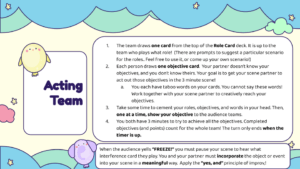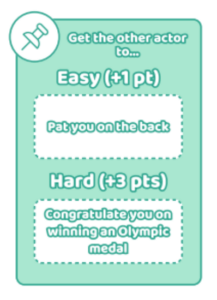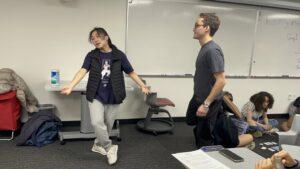Team: Miranda Diaz, Ember Fu, Annie Nguyen, Jasmine Steele
Overview:
“Two-Man Show!” is a game designed to teach improv acting and the other skills within it, such as applying the technique of “yes, and”! Best played with 4 or 6 players, players work in teams of two to act out a scenario directed by a given “paired role”. This could be anything from a Cop and Robber, Superhero and Supervillain, or the ever-dramatic Dumper and Dumpee! Each player will also draw their own Objective card, detailing an easy and hard objective they must accomplish within the improv scenario to earn points. To win, the pair must work together without knowing each other’s goals and earn the most points in their show. Meanwhile, the audience knows both of the players’ objectives and possess Interference cards–so as they enjoy the performance, they can throw all kinds of objects and events that must be incorporated into the scene. How well can our actors deal with these sudden new interjections while working towards their goals? The show must go on!
Two-Man Show! includes fellowship, expression, fantasy, and challenge as its types of fun. Fellowship is prevalent throughout the game as players are directly brought together to interact in creative, zany, and collaborative ways. With a team-pair competition format, players are given an incentive, but overall the lighthearted nature of the game promotes plenty of laughter and socialization. The prompts also give players directions to work with, and the roles themselves being “paired” in nature lay the foundations for funny acting dynamics. At the same time, these prompts simply provide scaffolding–the improv show can be taken anywhere the player pleases, encouraging expression! With this creative freedom as well as some nudging with roles like Vampire and Werewolf, we can also find fantasy in the shows. And besides improv itself, trying to accomplish specific objectives competitively, while handling the various interference cards the audience may throw at them, can prove to be quite a difficult task! This adds an enjoyable layer of challenge to the game, that can be tailored to player experience with the levels of easy and hard objectives provided.
We wanted to create this sort of game because not only is improv a fun activity, but it also encourages people to practice creative and collaborative problem solving. Feeling more comfortable trying new things and thinking outside the box is a useful skill found within improv, alongside our “yes, and!” mantra that teaches players to stay open-minded and build off others’ ideas. Making improv and these related subskills accessible were the major goals of Two-Man Show. We were inspired by other similar games that involved role-play, secret objectives, and player interaction such as LARPing, charades, Betrayal at the House on the Hill, Secret Hitler, and Monster Seeking Monster.
Rules:
The rules for Two-Man Show! can be accessed here, as well as seen below!




Game Bits:
Below shows part of the Figma, which can be found here. It entails:
- 54 Cards in total
- 36 Audience Interference Cards
- 12 Objective Cards
- 6 Paired Role Cards

Assessment:
Our assessment goals revolved around if we were achieving the following: Less experienced or new players were comfortable playing the game; all players are improving and able to practice getting better at improv throughout the game; all players are actively and consistently practicing skills such as “yes, and”. Quantitatively, we were able to measure how many points players were able to accumulate, both as a team and individually, during their shows. The more points accumulated, the better their progress, as collecting points depends solely on their ability to improv their objective effectively. We also took active note of the players’ specific actions, such as when they were or weren’t following the rules of improv well or other moments of confusion. We achieved these goals increasingly well as we iterated on our game. For instance, players at first sometimes got into standstills where they were “no, but”-ing their partner instead of progressing the scenario together. As we revised our game, these moments virtually disappeared and led to smoother performances. Point totals as well got better in subsequent playtests and rounds within playtests.
We also wanted to pay attention to the level of comfort players, particularly inexperienced ones, had in playing the game from the get-go. To ease new players into improv while also challenging them to improve and get more creative, we added easy and hard objectives to scaffold players in gradually improving their skills. The harder objectives involved specific actions that might be harder to incorporate into a scene given the actors’ roles and scenario. Players were incentivized to be more creative and reach the harder objectives since they had a higher point value. This was a softer metric to measure, as it varied depending on the player. Those who were more new to improv sometimes stayed on trying to achieve the easier objective, others decided to go for it. In addition, we added suggested scenarios with each role card. The original intent was to support unsure players; those new to improv might not know quite what to do with a particular role. This was immediately picked up by players, and now helps the general gameplay flow. The observed changes were qualitative, as new players showed more confidence in working with a provided scenario rather than without one.
History:
Playtest #1
We had our first playtest in class on January 19, 2023 with six players total. Our players were four men and two women, none of which had significant previous experience with improv. All playtesters were young adults studying at Stanford. At this point, Two Man Show was quite different from its final state. Most notably, the two actors in a performance were competing against each other rather than working together. Scores were held by individual actors rather than teams of two. This mechanic was intended to create a competitive dynamic between the actors since they would want to complete their objective while blocking the other player from completing theirs. Additionally, there was only one objective on all of the objective cards, and the taboo words mechanic did not exist. There was no suggested scene provided on the role cards. Each player was given three interruption cards to use throughout the entire game, and there was no limit on how many interruption cards the audience could play per performance. The rule of not saying “no” did not exist. Lastly, the mechanic of the audience shouting “FREEZE” did not exist at the start of the game but was quickly modded in on-the-spot thanks to Gilbert’s recommendation.
Some of the key observations from the first playtest are as follows:
- Players tried to achieve their objectives as quickly as possible and would force the scene in a new direction even when it conflicted with what was currently happening.
- Pairs of actors would end up in a stalemate where both actors want to take the scene in a certain direction and deny to go along with the other.
- Actors quickly guessed what the other actor’s objective was and avoided it at all costs.
- One actor was struggling to figure out what to say during their performance. They weren’t sure what it meant to act out their role as a “superhero”.
- One actor directly commanded the other actor to do the objective and won within seconds.
- Actors would strategically pick a role that made it easier for them to fulfill their objective.
- Players loved the interference cards and played them as much as possible.
- Players would use accents and silly voices to get into character. They would make good use of space, rolling around on the floor if necessary.
- There were lots of happy play noises to be heard!
From these observations, we realized that the players were rewarded for being timid and not taking sporadic actions because they were worried about accidentally completing the other actor’s objective. This was an unintended dynamic that did not align with our learning objectives and needed to be addressed. The first change that we decided on was that the pairs of actors should score points together as a team; thus, they would be motivated to help each other complete their secret objectives. By shifting the dynamic between actors from competitive to collaborative, we could also address the stalemate problem that we noticed. Moreover, it would not be a problem if players chose roles strategically or guessed their partners objectives because it allows them to better complete their objectives as a team. With this change, we needed to make it impossible for players to directly tell their acting partner what their objective is.
To do this, we added the mechanic of taboo words which were three words related to their objective that the player could not use during their performance. This also alleviates the problem of players directly commanding their partner to complete their objective. Another crucial pain point that we wanted to address was the one player who was struggling to figure out what to do with their role. We identified this player as an example of someone who might need additional guidance in learning about improv. To help players like this, we added scaffolding to our role and objective cards. Role cards would now have a suggested scene description that players could use as a starting point for their performance. Objective cards would now have an easy objective option (worth one point) and a hard objective option (worth three points). With this additional support, players can play at a level of difficulty that feels appropriate to them. Lastly, we decided to add more interference cards since players loved them so much. Players would now start the game with three interference cards and gain one additional interference card after each performance. However, they can have a maximum of three interference cards in their hand at once.
Playtest #2
We had our second playtest on January 23, 2023 with four players total. Our players were three women and one non-binary person, one of which had significant previous experience with improv. All playtesters were young adults studying at Stanford. The game was played with the modifications explained above.




Some of the key observations from the second playtest are as follows:
- Players in the audience would show each other their interference cards and scheme collaboratively.
- Players used the suggested scenes on their role cards.
- Players used random objects around them as props!
- Moderator needed to repeatedly remind actors of how much time was left.
- Players would occasionally ignore interference cards played by the audience or acknowledge them with a single “wooooo” before returning to the scene.
- One player forgot their objective.
- Taboo words made objectives more challenging, but players came up with creative ways to talk around the taboo words.
- The team that had the player with previous improv experience was able to complete all of the objectives and ultimately won the game.
- Players suggested allowing them to write their own objective cards as part of the game.
- The gameplay was again loud, fun, and rambunctious with lots of laughter and sound effects!
The main problem that we encountered during this playtest was the fact that actors would occasionally ignore or not really incorporate the interference cards. We believed that this could be addressed by building into the rules that players must incorporate interference cards with at least a sentence-long reaction. They cannot throw away or otherwise destroy the objects added to the scene via interference cards. Additionally, we decided that our game should have an assigned timekeeper for each performance, likely a player in the audience. This allows actors to keep track of time even when we are not there to moderate the game. Lastly, we liked the idea of players writing their own objective cards. While we ultimately decided not to explore this option during this assignment, we think it could be a fun direction to try out if we decide to work on the game further in the future.
Playtest #3
We had our third playtest on January 24, 2023 with four players total. Our players were three women and one man, one of which had significant previous experience with improv. All playtesters were young adults studying at Stanford. The game was played with the modifications explained above.


Some of the key observations from the third playtest are as follows:
- One player did not know what our game was intending to teach but exclaimed “OH THIS IS IMPROV! THIS IS GREAT!” after learning the rules.
- Audience was again collaborating to interfere with the performance.
- Audience fell to the floor laughing during the performance. There was lots of laughter and clapping!
- Actors were very expressive with their movements.
- One player misunderstood the objective and thought they needed to do the action themselves.
- Actors again chose their roles strategically but now with the help of their acting partner.
- Audience played a lot of interference cards as the actors got close to their objectives. This made it difficult for the actors to keep a consistent story going.
This playtest helped us identify some problems with the design of our objective cards. The cards said “Get the other player to…” at the top and listed the separate easy and hard objectives below, like “pat you on the back” and “congratulate you for winning the Olympics”. It was easy for players to overlook the text at the top of the card and assume they themselves should do the actions that were listed under easy and hard. We addressed this problem by reformatting our objective cards such that the “Get your partner to…” phrase was built into each of the easy and hard objectives respectively. Lastly, we wanted players to be able to keep a more consistent storyline. To do this, we added the rule that the audience could collectively play a maximum of four interference cards per performance. This encourages the collaborative dynamic that we already observed amongst audience members and adds a new dynamic where the audience needs to be more strategic about when/how they use their interference cards. All of these changes lead us to the latest iteration of Two Man Show.
Old (first) and New (second) Objective Card Comparison:


Playtest #4 (Final)
We had our final playtest on January 26, 2023 with four players total. Our players were two women and two men, one of which had significant previous experience with improv. All playtesters were young adults studying at Stanford. The game was played with the modifications explained above.




Some of the key observations from the final playtest are as follows:
- Players skimmed the rules because there was too much text. They thought the rules highlight high-level goals like “Work with your partner to complete secret objectives!”
- One player completed the easy and hard objective within the first minute. They wanted to be able to draw another objective card after entirely completing the first.
- Players wanted to play more rounds but thought it would be fun to switch partners after two.
- Actors used exaggerated voices and body movements during their performance. This brought a lot of laughter from the audience!
- One player asked “Are you going to sell this?!” after they finished playing. Another said, “This would be fun to play as a drinking game or at parties.”
Overall, we think our final playtest was a success. Players had lots of fun while practicing fundamental improv skills. They were able to play at a difficulty that matched their level of mastery and get feedback on their performance from their score count and fellow players. The final change that we made to Two Man Show was revisiting our rulebook and making the wording more concise. This playtest also added to the list of possible future directions that our game could explore.
Summary of possible future directions for Two Man Show:
- Players writing custom objective cards for the game
- Game lasting more round with players switching partners at some point
- Players picking up more objectives as they complete their current set
- Exploring more ways to incorporate physical space into the mechanics
Print & Play:
For those who want to play at home, here is the PDF for the Print and Play version!



